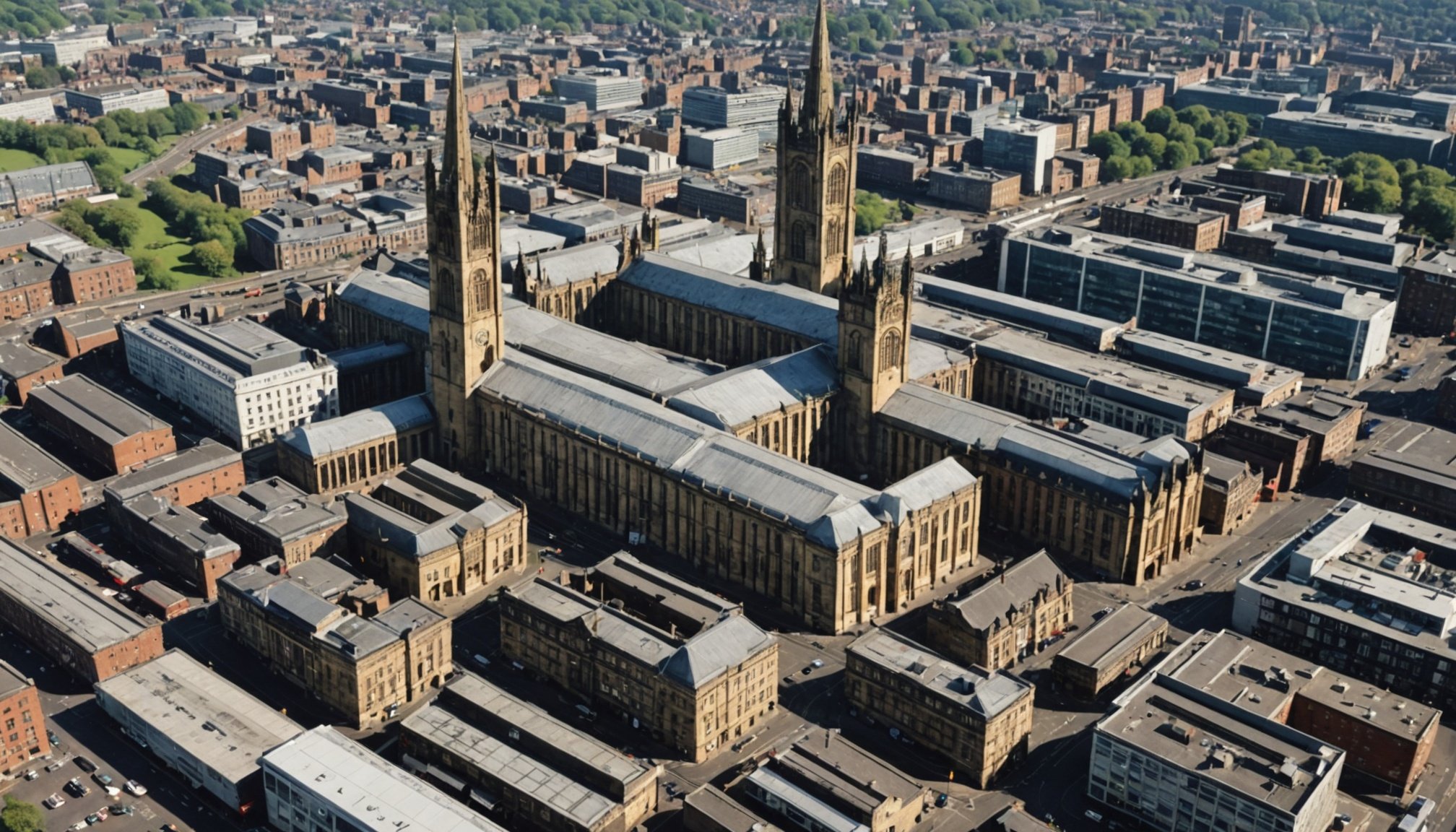Uncovering Opportunities for Technological Infrastructure Enhancements in Leeds: A Guide to Strategic Identification
Understanding the Need for Infrastructure Enhancements
In the vibrant city of Leeds, the pursuit of technological infrastructure enhancements is not just a necessity, but a catalyst for economic growth, innovation, and sustainable development. As Leeds continues to evolve as a hub for health research, technology, and digital innovation, it is crucial to identify and capitalize on opportunities that can drive long-term progress.
The Role of Government and City Council
The Leeds City Council plays a pivotal role in driving these initiatives. For instance, the council’s strong endorsement for the new hospital plans, as highlighted in recent reports, underscores their commitment to enhancing public services and infrastructure. Councillor Fiona Venner emphasized, “The new hospital will boost the health of children and adults in this city as well as regenerating the existing and surrounding site. It will play a vital part in tackling health inequalities and improving health outcomes for people in Leeds and the region.”
Lire également : Discover Essential Age-Friendly Home Features for Senior Living in Norfolk
This support from the government and city council is essential for securing the necessary funding and approvals to move forward with large-scale projects. The proposed new hospital, part of the Hospitals of the Future project, is expected to create 4,000 new jobs, develop 1,000 new homes, and generate an estimated £13 billion in economic impact, making it a cornerstone of local economic growth and innovation.
Identifying Key Areas for Investment
To strategically identify areas for technological infrastructure enhancements, it is important to focus on sectors that have the potential for significant impact.
A voir aussi : Discovering Rural Cornwall: Your Guide to Properties with Excellent Public Transport Access
Transportation Infrastructure
Leeds is currently undergoing significant improvements in its transportation infrastructure. The Transpennine Route Upgrade, for example, has been granted the Transport and Works Act Order, enabling major improvements between Leeds and Micklefield, including level crossing upgrades. This project is a prime example of how investment in transportation can enhance connectivity and support economic growth.
Additionally, the recent roadworks across Leeds, while causing temporary disruptions, are aimed at improving the city’s road infrastructure. These works, affecting areas such as Otley, Horsforth, and Hunslet, are necessary for maintaining and enhancing the city’s public transportation network. As noted, “the improvements are expected to provide smoother journeys and more reliable bus services for daily commuters once completed.”
Digital Infrastructure and Inclusion
Digital infrastructure is another critical area for investment, particularly in the context of digital inclusion and innovation.
Gigabit Broadband and Digital Services
The rollout of gigabit broadband is a key initiative in enhancing Leeds’ digital infrastructure. This high-speed connectivity is vital for supporting businesses, public services, and residents, ensuring they remain competitive in the digital age. The city’s focus on digital inclusion aims to bridge the gap between those who have access to digital services and those who do not, promoting inclusive growth and reducing digital disparities.
For instance, the University of Leeds has been actively enhancing its digital education systems, including updates to platforms like PebblePad and Blackboard, and introducing new tools such as FeedbackFruits for formative assessment. These advancements not only improve the learning experience but also ensure that students and staff are equipped with the latest digital skills.
Energy and Low Carbon Initiatives
As the world grapples with climate change, Leeds is at the forefront of low carbon initiatives and energy efficiency.
Net Zero Goals and Climate Change Mitigation
The city’s commitment to achieving net zero is reflected in various policy initiatives and investments in low carbon technologies. For example, the West Yorkshire Digital Health Investment Zone is not only focused on health innovation but also on integrating sustainable and low carbon solutions into its infrastructure. This approach ensures that economic growth is balanced with environmental sustainability.
Public-Private Partnerships and Research Innovation
Public-private partnerships are instrumental in driving technological infrastructure enhancements in Leeds.
Collaborative Approaches to Innovation
The Leeds Innovation Partnership, which includes the Leeds City Council, University of Leeds, and Leeds Beckett University, is a prime example of how collaborative efforts can drive research innovation and development. This partnership fosters an environment where public and private sector entities can work together to identify and address key challenges, leveraging each other’s strengths to achieve common goals.
For instance, the development of the Leeds Innovation Village, part of the new hospital project, is expected to generate thousands of jobs and significant economic benefits. This initiative highlights the power of public-private partnerships in driving growth and innovation.
Data-Driven Decision Making
Effective decision making in infrastructure enhancements relies heavily on data.
Utilizing Data for Policy Development
The use of data in policy development is crucial for ensuring that investments are targeted and effective. In Leeds, data is being used to inform decisions on where to invest in digital infrastructure, transportation, and other public services. This data-driven approach helps in identifying areas of need and measuring the impact of investments, thereby optimizing resource allocation.
Practical Insights and Actionable Advice
For those looking to contribute to or benefit from these infrastructure enhancements, here are some practical insights and actionable advice:
Staying Informed
- Keep up-to-date with the latest news and updates from the Leeds City Council and other relevant authorities.
- Subscribe to newsletters and follow official social media accounts to stay informed about ongoing and future projects.
Engaging with the Community
- Participate in public consultations and feedback sessions to ensure your voice is heard.
- Join local community groups and forums to stay engaged with other stakeholders.
Leveraging Digital Platforms
- Utilize digital tools and platforms provided by institutions like the University of Leeds to enhance your skills and stay connected.
- Take advantage of resources such as Box of Broadcasts (BoB) and other educational services to stay informed and educated.
Detailed List of Opportunities
Here is a detailed list of opportunities for technological infrastructure enhancements in Leeds:
-
Transportation Upgrades:
-
Transpennine Route Upgrade
-
Roadworks in Otley, Horsforth, and Hunslet
-
Improvements to bus services and routes
-
Digital Infrastructure:
-
Rollout of gigabit broadband
-
Enhancements to digital education systems (PebblePad, Blackboard)
-
Introduction of new digital tools (FeedbackFruits)
-
Energy and Low Carbon Initiatives:
-
Achieving net zero goals
-
Integration of low carbon solutions in the West Yorkshire Digital Health Investment Zone
-
Public-Private Partnerships:
-
Leeds Innovation Partnership
-
Development of the Leeds Innovation Village
-
Data-Driven Decision Making:
-
Using data to inform policy development
-
Measuring the impact of investments through data analysis
Comprehensive Table: Key Infrastructure Projects in Leeds
| Project | Description | Expected Impact | Key Stakeholders |
|---|---|---|---|
| Transpennine Route Upgrade | Major improvements between Leeds and Micklefield, including level crossing upgrades. | Enhanced connectivity, economic growth. | Transport and Works Act Order, Leeds City Council. |
| Roadworks in Leeds | Temporary road closures for essential roadworks. | Improved road infrastructure, smoother journeys. | Leeds City Council, local residents. |
| New Hospital Project | New hospital for children and adults, including a centralized maternity center. | 4,000 new jobs, 1,000 new homes, £13 billion economic impact. | Leeds City Council, Leeds Teaching Hospital Trust (LTHT). |
| Gigabit Broadband Rollout | High-speed internet connectivity across the city. | Enhanced digital services, business competitiveness. | Private sector providers, Leeds City Council. |
| Digital Education System Upgrades | Updates to platforms like PebblePad and Blackboard. | Improved learning experience, enhanced digital skills. | University of Leeds, IT Services. |
| West Yorkshire Digital Health Investment Zone | Integration of digital and low carbon solutions. | Sustainable and innovative health infrastructure. | West Yorkshire Integrated Care System (ICS), West Yorkshire Association of Acute Trusts (WYAAT). |
Leeds is at the cusp of significant technological infrastructure enhancements, driven by a combination of public sector support, private sector investment, and innovative policy initiatives. By understanding the key areas for investment, leveraging data-driven decision making, and engaging with the community, Leeds can ensure that these enhancements not only meet current needs but also pave the way for long-term growth and innovation.
As the city continues to evolve, it is clear that these infrastructure enhancements will be crucial in maintaining Leeds’ reputation as a travel-friendly, economically vibrant, and technologically advanced city. Whether through improved transportation links, enhanced digital services, or low carbon initiatives, Leeds is poised to become a model for sustainable and inclusive growth, benefiting both its local residents and the wider global community.











